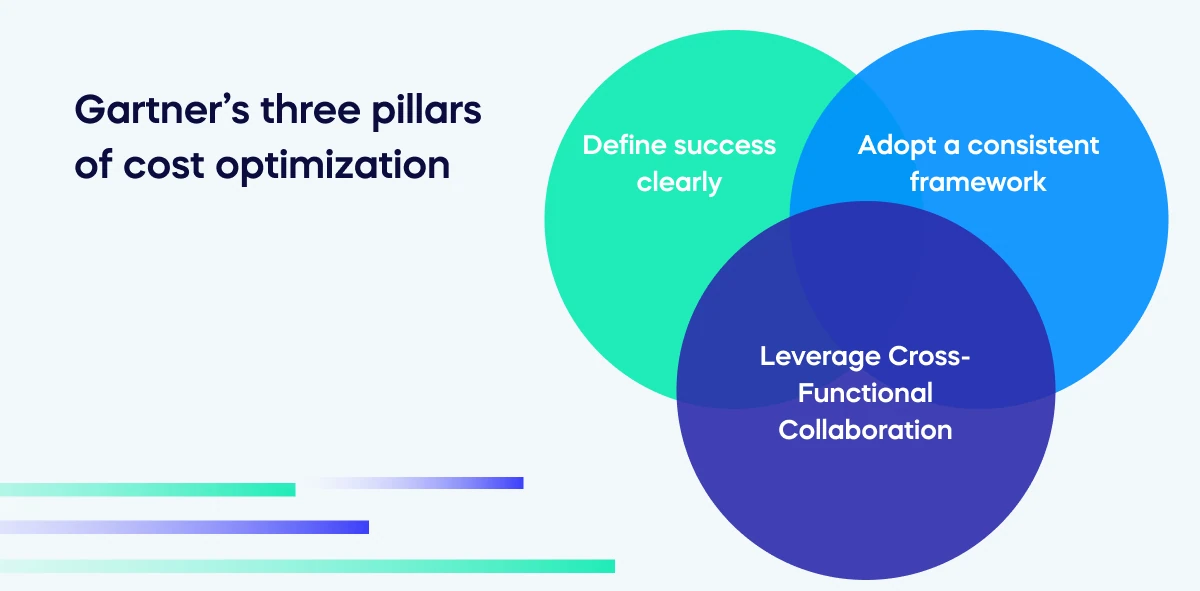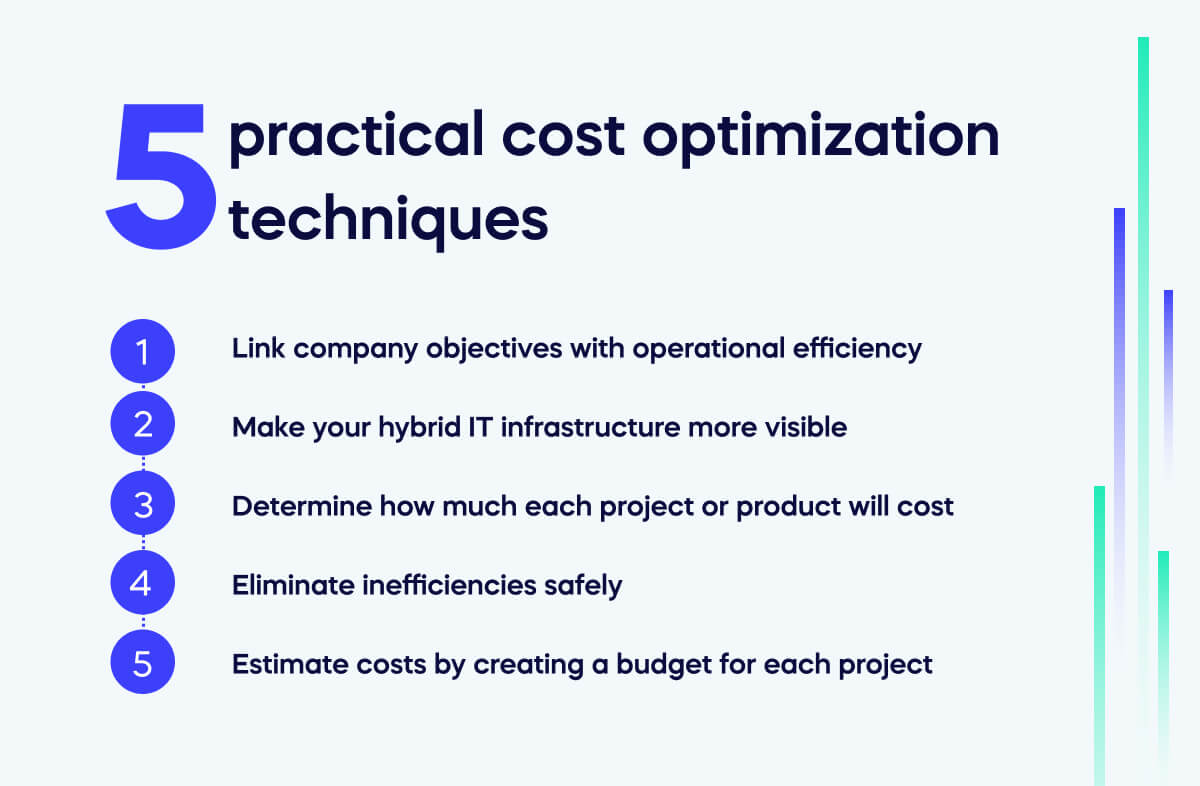What is cost optimization?

Table of contents
- What is cost optimization?
- Cost optimization definition
- Why every business needs cost optimization
- Three approaches to strategic cost optimization
- Gartner’s three pillars of cost optimization
- The four pillars of cloud cost optimization
- Five practical cost optimization techniques
- Best Practices To Optimize Costs
- Cost Savings & Digital Transformation
- Cost optimization for 2024
Cost optimization definition
Cost optimization is the act of reducing company spending while maximizing business value. Normally, cost optimization includes:
- Making business purchases at a lower cost.
- Standardizing and streamlining platforms, applications, processes, and services.
- Automating IT and business operations.
Companies benefit from strategic cost optimization when they know these aspects of the definition, allowing them to drive business value. Cost optimization is not the same as spending and cost reduction. Cost reduction only concerns how much something costs, while cost optimization considers all requirements and constraints. Company leaders must strive to redefine significant successes and objectives across departments instead of encouraging workers to focus on a single target. This action spurs employees to collaborate towards a goal. It is also necessary to streamline supply chain systems that promote workplace division. But why is cost optimization necessary in the first place?
Why every business needs cost optimization
The biggest companies are effective because they ensure that every cent is costed. Every business can engage with cost optimization to ensure that they remain profitable. Today, one of the major challenges in these businesses is the sprawl of digital systems. Because of the niche uses of these apps, companies maintain subscriptions even if they become unnecessary and unused. This lack of oversight leads to vast amounts of waste and missed opportunities for cost-cutting. Cost optimization becomes effective when companies implement cloud financial management. This ensures companies optimize cloud computing expenditure to extract the highest value from their resources. Doing so ensures that you’re only paying for technology that provides additional value to your business. Gartner reports that more than half of large businesses do not have clear measures of success for their cost management initiatives. Many organizations are wasting resources due to a lack of cost-optimization strategies. To ensure that your company uses cost optimization efficiently, you should take a strategic approach to cost optimization. The next section will introduce three ways of creating a good cost-optimization strategy.
Three approaches to strategic cost optimization
Cost optimization is most useful when it is strategic. Creating a strategy from scratch is hard. It’s especially difficult because cost optimization might connect with other business areas – like digital change management projects, IT strategic planning, etc. In this simple glossary entry, we can’t provide all the techniques for business cost optimization – but we can introduce some of the important models for improving costs. These will include:
- Gartner’s three pillars of strategic cost management.
- The four pillars of cloud cost optimization;
- Five practical techniques for cost optimization.
Together, these will guide you to improve your cost optimization processes.
Gartner’s three pillars of cost optimization
To begin with, we’ll take a look at a general approach to business cost optimization. In particular, Gartner’s three pillars of its strategic cost optimization framework support a business-focused approach to savings plans. The three pillars are to define success clearly, adopt a consistent framework, and leverage cross-functional collaboration.

- Define success clearly: What does success look like for your cost optimization? Does it mean specific savings goals – or increasing productivity metrics? Organizations should set realistic targets and strategic actions to meet them. Without them, slash-and-burn cost cuts can accidentally reduce your business capabilities. According to Gartner’s 2021 data, most organizations utilized multiple success metrics; however, 66% of companies defined the most common obstacle as achieving specific cost savings.
- Adopt a consistent framework: Organizations that used a cost management framework before the pandemic were less likely to have their budgets/costs cut. A clear framework allows for a shared understanding of which costs you can optimize and which must remain protected to pursue organizational goals. Organizations that use a systematic and methodical approach find validating their budgets to other interested parties simpler.
- Leverage Cross-Functional Collaboration: It is the final cost optimization pillar. Cross-functional collaboration is critical to driving impact (and is more common when a standard framework is in place). Start by identifying instances where functions depend on — or need to collaborate with — their peers to manage their cost drivers and address the areas of poor inter-departmental collaboration.
The four pillars of cloud cost optimization
Gartner helps give us the big picture. However, the reality is that cost optimization in different business units will require different demands. Here, we’ll hone in on cloud costs – an area that can get out of control far too easily. The four pillars to get your cloud spending in order are right-sizing, reserved instances, elasticity, and monitoring.
- Right-sizing supports cost optimization strategy by aligning resource allocation with actual utilization. Right-sizing reduces wasteful overprovisioning and prevents performance bottlenecks stemming from resource scarcity. This balance of supply and demand drives down unnecessary expenses and ensures resources are used to their fullest potential. As a result, organizations can maintain a lean cost structure while sustaining optimal performance levels.
- AWS outlines that by utilizing reserved instances, your organization has the potential to achieve up to 75% in cost savings. The general idea is that you agree to pay for a set amount of capacity over time, which entitles you to a discount. However, determining how much AWS capacity to purchase can take time and effort.
- Elasticity means using services when you need them – and turning them off when you don’t. This is one of the critical advantages of leveraging the public cloud. Key actions can involve automated scheduling methods, such as turning off non-production workloads at specific times of the day every day and increasing granularity in auto-scaling.
- Finally, the fourth and final pillar of cost optimization is to “measure, monitor, and improve” to establish a culture of transparency and accountability surrounding your organization’s cloud deployment. You can achieve such a significant cultural shift by setting appropriate KPIs.
Five practical cost optimization techniques

The specific elements of a cost optimization strategy are central to success. The first of these strategic cost optimization approaches is linking your company objectives with operational approach efficiency.
1. Link company objectives with operational efficiency. Companies constantly seek to grow revenue, so reviewing optimization against that metric is vital. However, “optimizing” cost means finding the correct cost, not the lowest. This approach prevents cost reduction from becoming a shortsighted endeavor: you don’t want to sacrifice long-term growth for immediate savings. By directly connecting cost-saving initiatives to strategic objectives, companies can prioritize investments in areas that drive sustainable value and competitive advantage.
2. Make your hybrid IT infrastructure more visible. Organizations need complete visibility into all their assets to optimize the cost of IT services. With hybrid IT becoming the norm for nearly every organization, gaining insight has never been more critical. To gain insight into how your hybrid services are functioning, you need a tool like Walkme that provides unified visibility and analysis for every aspect of your environment
3. Determine how much each project or product will cost. To calculate cost savings correctly, you first need to figure out the cost structure of your operating environment. Costing third-party cloud services (IaaS, PaaS, or SaaS) is relatively straightforward. You’ll need to do extra preparations if you have traditional infrastructure stored on-premises in your data center. However, it’s crucial not to get caught up striving for the perfect structure– begin with something basic that can be enhanced by adding new layers later.
4. Eliminate inefficiencies safely. Organizations must maintain the quality of their products or services while reducing unnecessary expenditures. The emphasis on doing so “safely” underscores the importance of making changes in a controlled manner, preventing disruptions to vital functions or customer experiences. This method ensures that cost-saving efforts improve efficiency without introducing risks, ultimately fostering a more agile, economical, and resilient operational structure.
5. Estimate costs by creating a budget for each project. By meticulously planning and allocating resources for individual projects, organizations can gain clarity on anticipated expenses and potential cost-saving opportunities. This method fosters proactive decision-making, helping to prevent overspending and ensuring that resources are allocated efficiently. Moreover, project-specific budgets facilitate tracking expenditures, enabling timely adjustments if deviations occur.
Best Practices To Optimize Costs

Following best practices allows business value to increase within a structured process. The first of these best practices to optimize costs is to audit cloud costs.
Audit Cloud Costs
When examining your cloud spending, look at the potential areas of improvement and where you may have repeating systems. Businesses often find multiple cloud structures working on similar tasks – like security or administrating tools. There could also be portions of your development in the cloud that need more attention to be successful.
Enable Cross-Functionality
You may have noticed that there’s always a debate about how companies should allocate money between administrators, developers, and users. Even though they might all be correct from their perspective, the employees working on the ground will see where cloud costs must go. By having cross-functional teams, you’re less likely to spend money in places that aren’t needed and more likely to identify areas needing improvement.
Formulate Processes to Procure And Decommission
Unused or inactive organizational resources are often due to ineffective systems and processes. Organizations can reduce the chances of unwanted Shadow IT by reinforcing stricter controls when companies commission resources and ensuring IT departments decommission apps that are no longer needed.
Consolidate Idle Resources
Set up resource consolidation for idle systems to increase cost optimization. Systems used yearly don’t need to be kept in the front and center. While these resources may not be suitable for decommissioning, they may not need to utilize as many resources as they are. For example, organizations may want to have a multi-layered system where the most active resources have the highest availability, and the least active resources have the lowest levels of availability.
Utilize Integrated Optimization Tools
Azure and AWS both have cost optimization tools, which should be exhausted before searching for a third-party tool. Built-in technologies work perfectly with the infrastructure and don’t come at an additional cost.
Cost Savings & Digital Transformation
One of the most important goals of digital transformation is cost savings. Businesses can free up resources by streamlining processes and automating tasks. Digital transformation can also help companies optimize costs by identifying areas where they waste resources. However, digital transformation is about more than just cost savings. It generates savings by improving efficiency, effectiveness, and customer satisfaction. When implemented correctly, digital transformation helps firms to achieve their goals and create lasting business value.
Further reading
Cost optimization involves much change for staff, so you must implement change management theories. Cost optimization is also part of digital transformation strategies. It is also essential to incorporate customer experience into every cost optimization strategy to maintain service quality despite savings.
Cost optimization for 2024
In 2024, businesses find cost optimization more important than ever. According to ISG research, most enterprises aim to reduce their outgoings by as much as 7%. This does not sound like a huge figure, but it’s a major commitment for businesses already running efficiently with significant risks. So today, cost optimization is in the minds of many business leaders. Plan carefully, and you have every chance of success. Reducing costs is not a guarantee of business growth but is a step in the right direction. When you implement cost optimization as a continuous discipline, the rewards will show themselves yearly.